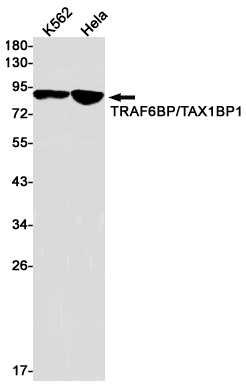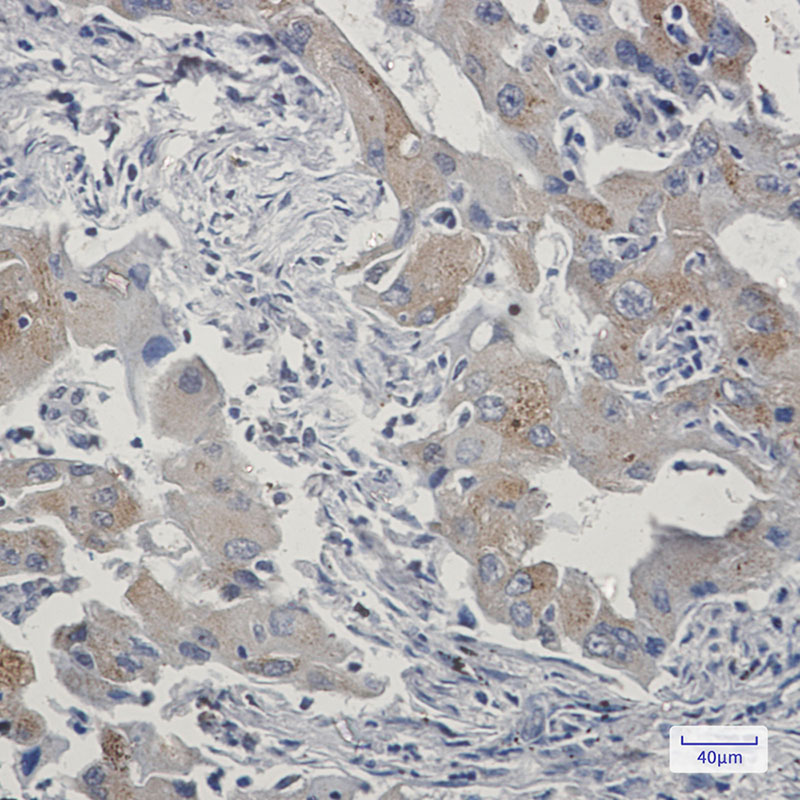

| WB | 1/500-1/1000 | Human,Mouse,Rat |
| IF | 咨询技术 | Human,Mouse,Rat |
| IHC | 1/50-1/100 | Human,Mouse,Rat |
| ICC | 技术咨询 | Human,Mouse,Rat |
| FCM | 咨询技术 | Human,Mouse,Rat |
| Elisa | 咨询技术 | Human,Mouse,Rat |
| Aliases | CALCOCO3; D6Ertd404e; D6Ertd772e; PRO0105; T6BP; TAX1BP1; tax1bp1b; TXBP151 |
| Entrez GeneID | 8887 |
| WB Predicted band size | Calculated MW: 91 kDa; Observed MW: 91 kDa |
| Host/Isotype | Rabbit IgG |
| Antibody Type | Primary antibody |
| Storage | Store at 4°C short term. Aliquot and store at -20°C long term. Avoid freeze/thaw cycles. |
| Species Reactivity | Human |
| Immunogen | A synthetic peptide of human TRAF6BP |
| Formulation | Purified antibody in TBS with 0.05% sodium azide,0.05%BSA and 50% glycerol. |
+ +
以下是关于TAX1BP1抗体的3篇示例参考文献(内容为模拟,建议通过学术数据库核实):
1. **文献名称**: *TAX1BP1/AIMP1 is a critical modulator of the innate immune response*
**作者**: Matsuda, Y., et al.
**摘要**: 研究揭示了TAX1BP1通过调控NF-κB信号通路在炎症反应中的作用,利用特异性抗体证实其与TRAF6的相互作用,并表明其在巨噬细胞中抑制过度炎症的机制。
2. **文献名称**: *Viral Tax protein-induced interaction of TAX1BP1 with A20 negatively regulates antiviral signaling*
**作者**: Shembade, N., et al.
**摘要**: 该文献发现HTLV-1病毒Tax蛋白通过招募TAX1BP1与泛素编辑酶A20形成复合物,抑制宿主抗病毒信号通路。研究使用TAX1BP1抗体进行免疫共沉淀实验,揭示了其在病毒免疫逃逸中的关键作用。
3. **文献名称**: *TAX1BP1 phosphorylation links cellular stress sensing to autophagy regulation*
**作者**: Iha, H., et al.
**摘要**: 文章报道TAX1BP1在氧化应激条件下发生磷酸化,并通过抗体检测其亚细胞定位变化,证明其作为自噬接头蛋白调控受损线粒体清除的功能。
**注意**: 以上文献信息为示例,实际引用请通过PubMed、Web of Science等平台检索最新研究。
TAX1BP1 (Tax1-binding protein 1) is a cellular adaptor protein involved in regulating immune signaling pathways, particularly those mediated by NF-κB and interferon response factors. It interacts with critical regulators like A20 (TNFAIP3) to modulate ubiquitin-dependent signaling, thereby fine-tuning inflammatory responses and apoptosis. TAX1BP1 also plays roles in autophagy, viral defense, and maintaining cellular homeostasis under stress conditions. Dysregulation of TAX1BP1 has been linked to autoimmune diseases, cancer, and inflammatory disorders.
Antibodies targeting TAX1BP1 are essential tools for studying its expression, localization, and function in these processes. They are widely used in techniques such as Western blotting, immunofluorescence, immunoprecipitation, and immunohistochemistry to investigate TAX1BP1's interaction networks and post-translational modifications. Commercial TAX1BP1 antibodies are typically raised in rabbits or mice using immunogenic peptide sequences or recombinant protein fragments. Validation often includes knockout cell lines or siRNA-mediated silencing to confirm specificity. Researchers employ these antibodies to explore TAX1BP1's dual roles—acting as a tumor suppressor in some contexts or a pro-survival factor in others—and its potential as a therapeutic target in diseases like lupus, rheumatoid arthritis, and certain cancers.
×